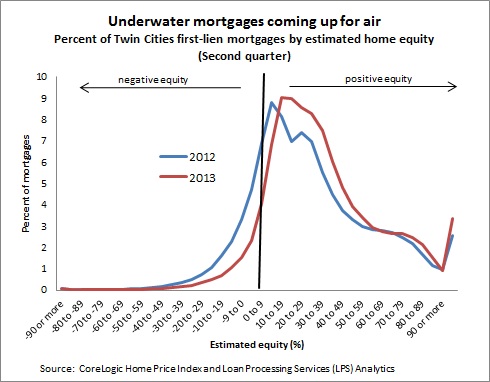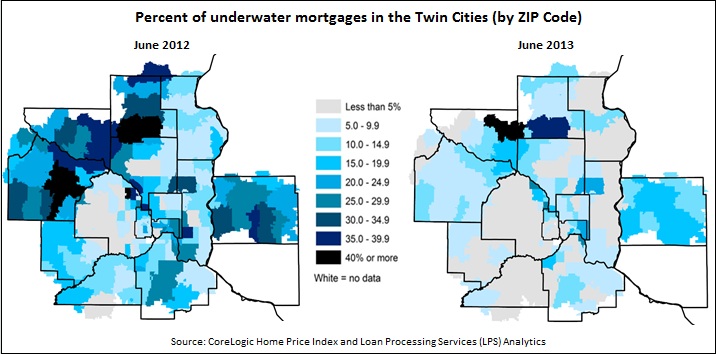A number of recent and positive trends, including home price appreciation and increased home sales, have been well documented in the Twin Cities housing market. Collectively, they suggest that the region’s housing market is continuing to recover.
More evidence of that recovery comes from the number of first-lien mortgages with negative equity, which declined by more than half between 2012 and 2013 (from 15.6 to 7.2 percent), according to calculations by the Minneapolis Fed using proprietary data from the CoreLogic Home Price Index and Lender Processing Services (LPS) Applied Analytics.
Negative equity—also referred to as being “underwater”—occurs when a borrower owes more on a mortgage than the current value of the property securing the loan. The recession and subsequent collapse of housing markets had a dramatic effect on home values, which pushed many homeowners underwater on their mortgages. In turn, this reduced the net worth of homeowners and became a drag on the economy.
Negative equity also has a number of harmful consequences for homeowners and communities. For example, despite historically low interest rates, underwater homeowners who opt to remain in their homes are typically unable to refinance into lower monthly mortgage payments. A lack of home equity removes a common financing option for home repairs and improvements. Those looking to move face high out-of-pocket costs to pay off their loan at the time of sale, which may have motivated some—particularly those severely underwater—to strategically default on the mortgage, adding to the pool of foreclosures.
Nationally, the percent of residential properties with a mortgage and negative equity dropped from 22.3 in the second quarter of 2012 to 14.5 a year later, according to CoreLogic.In the Twin Cities, easily the largest real estate market in the Ninth District, 15.6 percent of all active first-lien mortgages in June 2012 were in negative equity, according to an October 2012 analysis.
Most of these underwater mortgages were originated between 2005 and 2007 and had a negative principle equity balance amount between -1 percent and -20 percent of the appraised value of the property. The percent of underwater first-lien mortgages varied across the region, but areas especially hard hit include the east side of St. Paul, Brooklyn Park, Brooklyn Center, Farmington, Woodbury, and several suburban and exurban areas in the northwest metro and western Wisconsin (see left map).
By June 2013 (the date of the most recent figures available), the number of first-lien mortgages with negative equity declined by more than half from the previous June (see chart below). A ZIP Code analysis by the Minneapolis Fed reveals a substantial decline of underwater first-lien mortgages in many parts of the Twin Cities region, especially the northwestern suburbs of Wright and Sherburne counties (see right map).
Several areas of concern remain, though, especially where the housing market has not recovered as strongly. These areas include the east side of St. Paul, Maplewood, Brooklyn Park, Brooklyn Center, Zimmerman, and Isanti. While most areas of St. Croix County in Wisconsin improved, the share of first-lien mortgages with negative equity in that county remained higher than in the rest of the metropolitan area.


Michael works to advance the economic well-being of Indian Country and low- to moderate-income individuals, households, and communities. He has conducted research and published articles on affordable housing, community development corporations, homeownership disparities, and foreclosure patterns and mitigation efforts.





